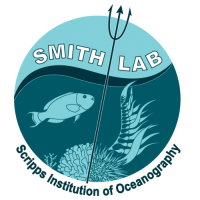The effect of simulated sea turtle grazing on the productivity and community composition of seagrass beds in Bocas del Toro, Panamá
Abby Cannon; Jennifer Smith
 Project description: PhD candidate Abby Cannon studies how animal disturbance affects seagrass beds in Bocas del Toro, Panamá. Disturbance by megafauna such as sea turtles plays a strong role in structuring marine plant communities. Abby has been conducting experiments in which she simulates grazing by trimming seagrass within treatment plots and monitoring their change over time as compared to control plots. Abby’s results show that seagrass beds in Bocas del Toro currently do not recover sufficiently from disturbance, likely because of sediment pollution blocking the sunlight and making it more difficult for seagrass to grow back after grazing. In order to restore sea turtle populations to their historical abundance, we need to improve the health of these marine ecosystems in addition to protecting the animals themselves. Abby’s research has also unexpectedly shown a tendency of stingrays to redisturb areas grazed by sea turtles (but not by manatees), and this may be related to the different effects of the two types of grazing on the invertebrate communities under the seagrass.
Project description: PhD candidate Abby Cannon studies how animal disturbance affects seagrass beds in Bocas del Toro, Panamá. Disturbance by megafauna such as sea turtles plays a strong role in structuring marine plant communities. Abby has been conducting experiments in which she simulates grazing by trimming seagrass within treatment plots and monitoring their change over time as compared to control plots. Abby’s results show that seagrass beds in Bocas del Toro currently do not recover sufficiently from disturbance, likely because of sediment pollution blocking the sunlight and making it more difficult for seagrass to grow back after grazing. In order to restore sea turtle populations to their historical abundance, we need to improve the health of these marine ecosystems in addition to protecting the animals themselves. Abby’s research has also unexpectedly shown a tendency of stingrays to redisturb areas grazed by sea turtles (but not by manatees), and this may be related to the different effects of the two types of grazing on the invertebrate communities under the seagrass.
Research questions:
- How does simulated grazing affect the productivity of seagrass in Bocas del Toro, Panamá?
- How does simulated grazing affect the benthic community composition of seagrass beds in Bocas del Toro?
- How do seagrass beds in Bocas del Toro respond to runoff events induced by heavy rainfall?

